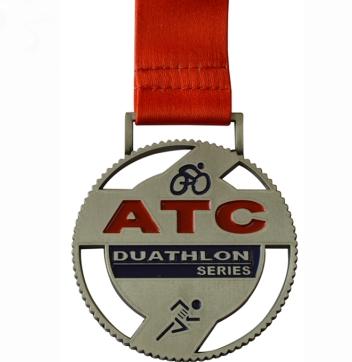Count the Different Production Techniques of Medals and Badges
The varieties of medals and badges are generally determined by their different production processes. The most common production processes for medals and badges include enamel, paint, imitation enamel, stamping, screen printing, die-casting, etc. Today, we will introduce different production processes and their characteristics.




1. Production process - enamel
As the most advanced coloring process, enamel is said to have been first recorded in the Yuan Dynasty, was most refined in the Ming Dynasty, and was already flourishing in the Qing Dynasty. Enamel badges, also known as cloisonné badges, are colored with enamel powder on red copper (purple copper). The color is dark and single, the cost is high, and it is fragile and cannot be knocked or faded by gravity. However, because of its strong color fixation and long preservation time, it is generally chosen to make commemorative medals that need to be preserved for a long time without fading, badges, medals, medals, etc. for state organs, military police, etc.
2. Production process - imitation enamel
Imitation enamel badges are generally colored with resin paint. The color is brighter than enamel and can be made of copper, zinc, alloy, etc. as the base material, with a strong sense of concave and convex. Soft enamel badges and resin are coloring materials developed by foreign experts. The surface can be plated with various metal colors such as gold and nickel. It is smooth and delicate, giving people a very noble feeling. It is suitable for high-end badge customization, mid-to-high-end commemorative medal production, commemorative medals and other exquisite products.
How to distinguish enamel from imitation enamel: Real enamel has a ceramic texture, less color selection, and a hard surface. Puncture the surface with a needle will not leave marks, but it is easy to break. Imitation enamel is soft, and a needle can pierce the fake enamel layer. The color is bright, but it cannot be preserved for a long time. After three to five years, the color will turn yellow after high temperature or ultraviolet radiation.
3. Production process-copper baking paint
The production process of copper baking paint is similar to enamel and soft enamel. The only difference is that the coloring material is baking paint. Because the copper material is relatively soft, the product surface has a very obvious concave and convex feeling, strong metal texture, clear lines, and bright colors. It is suitable for mid-to-high-end badges, medals, commemorative coins, key chains, and commemorative collection badges for enterprises and associations.
4. Production process - iron paint
Iron paint is cheaper than copper paint, but the quality is slightly weaker. The concave metal lines are relatively shallow, and the color is significantly lower than the metal line. It is suitable for low-end, large-volume, low-quality badges, medals, souvenirs, key chains, etc.
5. Production process - screen printing
Screen printing uses printing ink to print color on materials such as copper, stainless iron, and aluminum. There are no concave and convex metal lines on the surface of screen-printed badges, and there are no metal lines separating the colors, and the colors have no gradient effect. In order to protect the printed ink from being damaged, most products will be covered with drip glue to make the products brighter. Suitable for printing badges, large promotional souvenirs, and gifts.
6. Production process - die-casting badges
Die-casting badges are usually made of zinc alloy materials. Zinc alloy is made by casting technology, and the texture is relatively hard and can be highly polished. Because the melting point of zinc alloy materials is low, after heating and injecting into the mold, complex and difficult relief hollow badges can be produced. Suitable for badges, key rings and other products with delicate patterns, 3D effects and hollow inner holes.
Welcome to Karon to customize medals and badges (www.karonmetal.com), where excellent craftsmanship and creative design are perfectly combined to meet all your personalized customization needs.







